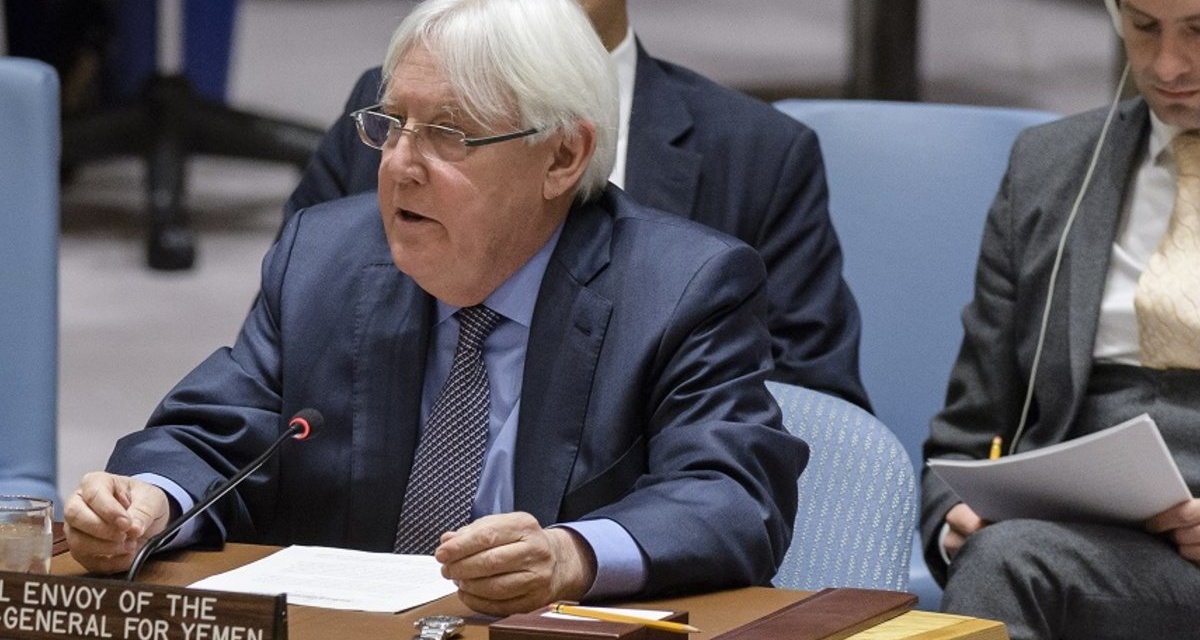Martin Griffith, UN Special Envoy for Yemen, addresses the Security Council, April 2018 (Manuel Elias/UN)
[Editor’s Note: EA contributor Jim Arbogast has just returned from a humanitarian aid mission in Yemen.]
Last week UN special envoy Martin Griffiths made his third trip in a month to Yemen, again urging the warring sides to withdraw troops from the port city of Hudaydah, a lifeline for millions of starving Yemenis.
The British diplomat is trying to save the minimal agreement that he managed to reach in December with some of the combatants, an accord seen by the international community as a significant achievement after several years of failure to bring the parties to the negotiation table.
But the Stockholm talks have to date translated into little change on the ground. The nominal ceasefire in Hudaydah has held insofar as the Ansar Allah (Houthi) insurgency and Government of Yemen have not abandoned the agreement. However, sporadic clashes have continued in parts of the city and the governorate’s southern districts, and they are increasing every week. A UN monitoring team continues efforts to implement the next stage of the pact, with mutual redeployment away from Hudaydah’s ports and city, but it faces accusations of bias from the Houthis, attacks on one of its vehicles, and boycotting of scheduled meetings.
While the UN Security Council passed a resolution on January 16 authorizing the deployment of a 75-member monitoring team, the increased international presence is not expected to counter an apparent reluctance to work out details on how to proceed. Time is of the essence: the Government of Yemen says it will not proceed with further talks until the Hudaydah agreement is implemented.
Since its set-up in early January, the UN’s Redeployment Coordination Committee — chaired by retired Dutch general Patrick Cammaert and tasked with overseeing the implementation of the Hudaydah Agreement — has encountered difficulties in bringing the two sides together to resolve ambiguities around the mechanism for redeployment and verification. The Houthis have questioned the impartiality of Cammaert, claiming he is biased towards the Government and the Saudi-led coalition as they refused to attend an RCC meeting on January 13.
There has been no meaningful movement of forces by either side. Plans for the management and security of the Hudaydah, Salif, and Ras Issa ports remain unclear. Proposals for enhanced roles for the World Food Programme, the UN Verification and Inspection Mechanism, and other UN-deployed monitors and experts are awaiting approval by the rival parties.
In other parts of the country, clashes have continued, or even accelerated most notably in Taiz, which was earmarked as the location for local de-escalation efforts during the Sweden talks. A Houthi drone attack on a military parade in Lahj on January 10th killed six high-ranking GOY officers and officials which, in the context of moving towards a political solution to the conflict, was interpreted as a sign of bad faith in an atmosphere of already-pervasive mistrust. And the coalition retaliated to this attack by conducting 21 airstrikes – targeting military sites and alleged UAV workshops – in 24 hours on the capital Sana’a, a volume of strikes unprecedented during the past 12 months.
Beyond Hudaydah, Houthi forces fired at least seven ballistic missiles at coalition forces and Saudi military sites between January 20 and January 29, targeting the Khalid Ibn Walid military camp in Taiz and military outposts along Saudi Arabia’s southern border districts of Jizan, Asir, and Najran.
In the south, tensions are high with discontent over the poor economic situation, frail security, and the presence of international actors such as the UAE and Saudi Arabia. Sit-ins and demonstrations are commonplace across the south, often driven by political factions in the areas. There have been clashes, particularly between UAE-backed security personnel and Government forces, testifying to mounting disputes within the anti-Houthi camp.
While the Houthis have apparently agreed to meet with a Government delegation to discuss future implementation of the Hudaydah agreement, there is little chance that the situation will improve if the political process is not more inclusive. So far only these two sides have been invited to negotiations, while diplomats use back channels to gather support from the main international actors such as Riyadh and the Emirates.
This does not deal with a civil war which is a variety of interconnected local conflicts involving regional powers competing for influence. In a second layer of conflict beyond the Houthi-Government fight, the Southern Transitional Council is making another bid for secession. Established in May 2017 by former Aden governor Aidarus al-Zubaidi and Salafist leader Hani bin Braik, the STC has extended its influence across Yemen’s southern governorate through a vast network of Emirati-backed militias — some of which are fighting against the Houthis in Hodeidah and, occasionally, against Government loyalists in southern and central governorates.
There is little hope that the peace process can be successful if the southern parties are not invited to the negotiation table. And at some point, the international community will have to look at the third layer of conflict, involving the Islamist insurgency of Al Qaeda in the Arabian Peninsula and the Yemeni branch of the Islamic State. While both groups currently possess limited operational capacities, AQAP controlled large swathes of territory in several provinces — including Mukalla, Yemen’s fifth-largest city — between 2015 and 2016. Often in competition with one another, AQAP and IS have also been reported to fight alongside pro-Government militias against the Houthis, in Al Bayda, Shabwah, and Ta’iz, further blurring a multi-level conflict.

